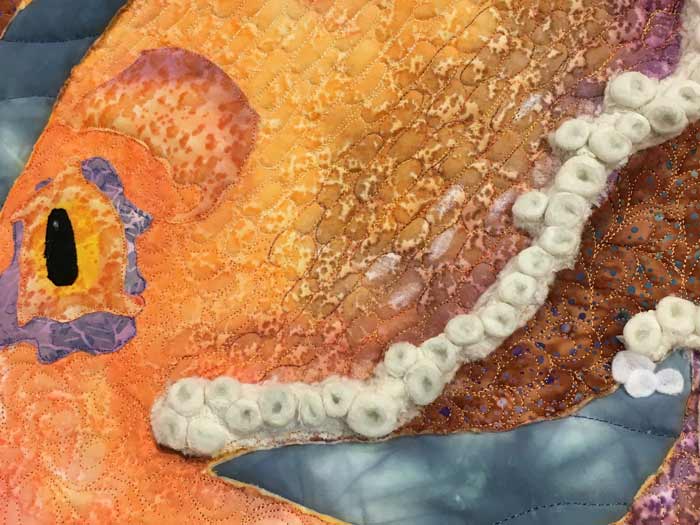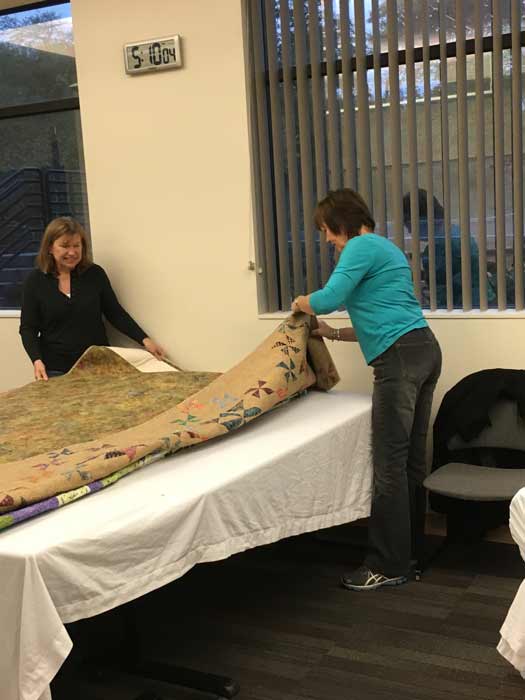On Wednesday I had the pleasure of judging for the Columbia River Gorge Quilters Guild in Hood River, Oregon. I arrived twenty minutes early, and they were already set up and raring to go. Their preparation–totally appreciated. This year as last they asked me to comment on all positive and constructive points. Their members want to know everything they can do to improve their work as well as learn what is successful in both design and workmanship. Normally, I don’t list all areas where a quilt can be improved. I feel it’s dispiriting and discouraging to the entrant. I wouldn’t want to be the reason a quilter quits quilting or entering shows. I don’t want to be considered a member of the quilt police. Instead, my goal is to encourage entrants. In that spirit, I generally select two areas, if there are two, which need the most improvement or those which can be easily improved. Ideally, the quilter takes these comments into account, applies them to his/her work, and the submission to the next show is that much better. Needless to say, this process takes longer than a typical judging day even though we use a sheet I’ve designed to speed up the evaluations and make them go faster.
Our Best of Show was from the traditional pieced category–large made by Anne Marie Martin. She was in strong contention last year so was particularly excited this year to win the big award. Here’s an image she took at the show and sent me. I wish you could see her precise workmanship and the quilting, which had quite a story behind it. She sent the quilt to a well-known longarm quilter with specific instructions on how she wanted it quilted. The quilter confirmed the instructions but did something quite different. While the quilting designs were gorgeous, (Anne Marie showed me photos), they didn’t fit the character of this traditional quilt. Anne Marie spent two weeks removing the quilting then took the quilt to another quilter recommended by the designer Pam Buda.

A Prairie Gathering by Anne Marie Martin
Here’s Anne Marie still looking giddy with delight after learning she had won BOS. She assisted all day as she has many times in the past.

Anne Marie Martin
Anne Marie also won an award for her quilt “Summer Blooms.” Note the impeccable workmanship. I was particularly taken with the X’s in the embroidered curved inner border. You can see from her two quilts her love for the country look.

Summer Blooms by Anne Marie Martin

Summer Blooms detail

Summer Blooms detail
Other quilts I loved for a combination of design, creativity, and workmanship:
The first is Penelope by Linda Reichenbach. This is creativity at its best. Notice how Linda felted wool for the suckers on the octopus’s tentacles and used zippers and French knots for the sea urchins. Oftentimes, during judging I see quilters trying unique techniques to convey ideas. Oftentimes, they aren’t successful with the quilts ending up looking crafty rather than artistic. Linda has succeeded with strong workmanship and composition.

Penelope by Linda Reichenbach

Sea urchin detail showing zippers and French knots

Octopus tentacles–detail
Another first place winner was Pieces of the Past embroidered and pieced by Catherine Campbell DuCharme. Meg Hawkey of Crabapple Hill Studio located in Benton City, WA is the designer. The quilt features a surface design technique to apply color, beautiful and extensive embroidery, and a quilting design that adds another dimension to the top design. If you are interested in this pattern, it’s #256 in the Floral and Feminine section on Crabapple’s website.

Pieces of the Past by Catherine DuCharme
Kathleen Roulet is an active quilter in the guild whom I have known for a number of years. She has organized or assisted every year I’ve judged the show.

Kathleen Roulet (left) and Anne Marie Martin (right)
Her work is beautiful. Here are her two prize winners. The first was completed for a guild challenge called “Make Mine Lime.”

Purple Poppies by Kathleen Roulet
I really admire this quilt from the fabrics chosen to depict Portland’s buildings to the wonderful quilting which creates the foreground roses.

View From the Rose Garden by Kathleen Roulet
This last quilt was my Judge’s Choice. The title is Tributaries, and it’s by Susan Stender of Hood River, OR. This is a quilt where the title is important in conveying the artist’s intent.

Tributaries by Susan Stender


